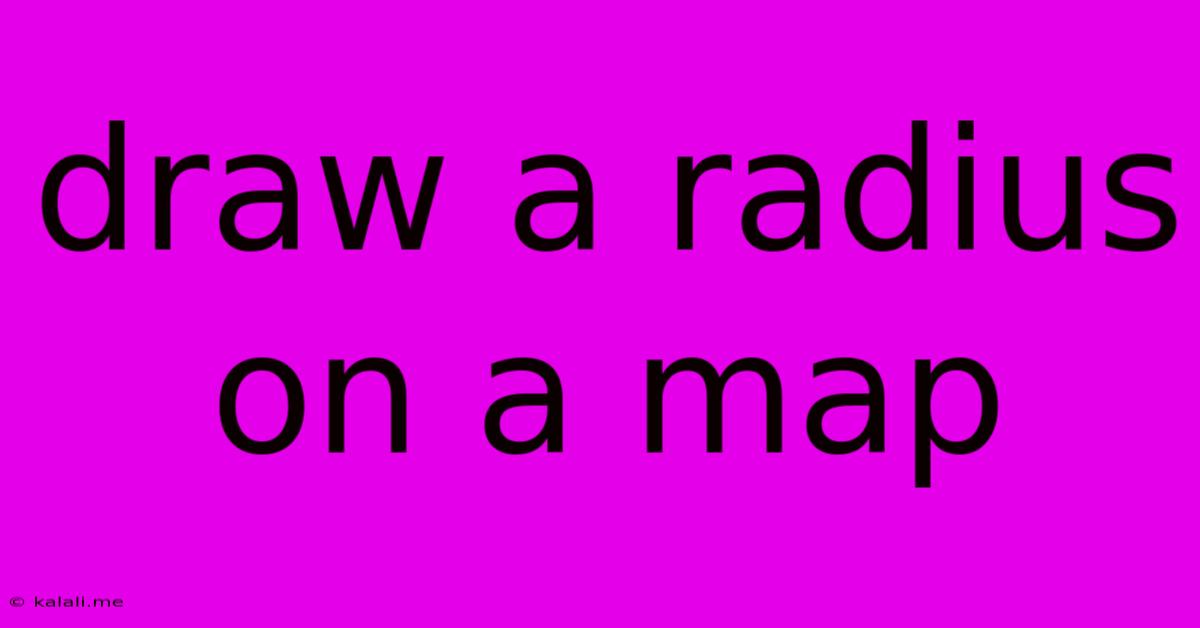Draw A Radius On A Map
Kalali
May 30, 2025 · 3 min read

Table of Contents
How to Draw a Radius on a Map: A Comprehensive Guide
Meta Description: Learn how to easily draw a radius on a map using various methods, from simple manual techniques to advanced digital tools. This guide covers everything from measuring distances to using online map services and GIS software.
Drawing a radius on a map is a crucial task for various purposes, from planning events and deliveries to analyzing geographical data and understanding spatial relationships. Whether you need to determine the reach of a service, visualize a specific area, or simply measure distances, knowing how to draw a radius effectively is essential. This guide will walk you through several methods, from simple techniques using readily available tools to more advanced digital solutions.
Method 1: The Manual Method (Using a Compass and Ruler)
This traditional method is perfect for quick estimations on printed maps.
- Identify your center point: Locate the precise point on the map from which you want to draw your radius. Mark it clearly.
- Set your compass: Adjust the compass to the desired radius distance. You'll need a scale on the map to convert the radius measurement (e.g., kilometers or miles) into the equivalent distance on the map.
- Draw the circle: Place the compass point on the marked center point and carefully draw a circle. This circle represents your radius.
Limitations: This method is less accurate for large radii and relies on the accuracy of your map's scale. It’s also not ideal for complex or large-scale projects.
Method 2: Using Online Mapping Services (Google Maps, Bing Maps, etc.)
Most online map services offer tools for measuring distances and drawing circles. These digital methods offer greater precision and convenience.
- Locate your center point: Use the search function to find your desired location.
- Utilize the measurement tool: Most mapping services have a "measure distance" or similar tool. Click on your center point, then drag to define the radius. Some services may let you input the exact radius distance directly.
- Observe the radius circle: The map will usually generate a circle representing your specified radius. You can often adjust the radius by dragging the outer edge of the circle.
Advantages: These tools are readily accessible, user-friendly, and provide a good level of accuracy. They also usually allow you to easily export your map with the drawn radius.
Method 3: Employing Geographic Information System (GIS) Software
For more advanced analysis and precise measurements, GIS software such as QGIS (open-source) or ArcGIS (commercial) offers powerful tools for creating buffers (which are essentially radii around points). These programs allow for complex analysis and integration with other geographic data.
- Import your data: Add your point data (the center of your radius) to the GIS software.
- Create a buffer: Utilize the buffer creation tool within the software. Specify your desired radius distance and other parameters like units.
- Analyze the result: GIS software allows for advanced spatial analysis, letting you overlay your radius with other layers of geographic data (e.g., population density, roads).
Advantages: This is the most accurate and versatile method, especially for complex projects. The resulting radius can be integrated into a wider analysis within the GIS environment.
Choosing the Right Method
The best method for drawing a radius on a map depends heavily on your needs and resources. For simple tasks and quick estimations, the manual method or online mapping services are sufficient. For more accurate, complex analysis, and integration with other geographic data, GIS software is the preferred choice. Consider the accuracy needed, the complexity of your project, and the tools readily available to you when making your decision. Regardless of the method, accurate measurement and clear visualization are key to utilizing the radius effectively.
Latest Posts
Latest Posts
-
Minecraft How To Use Redstone Repeater How To Make Repeat
May 31, 2025
-
Check Size Of Photos On Mac
May 31, 2025
-
How Do You Measure Punching Power
May 31, 2025
-
Car Heat Blows Hot Then Cold
May 31, 2025
-
What Type Of Christian Am I
May 31, 2025
Related Post
Thank you for visiting our website which covers about Draw A Radius On A Map . We hope the information provided has been useful to you. Feel free to contact us if you have any questions or need further assistance. See you next time and don't miss to bookmark.